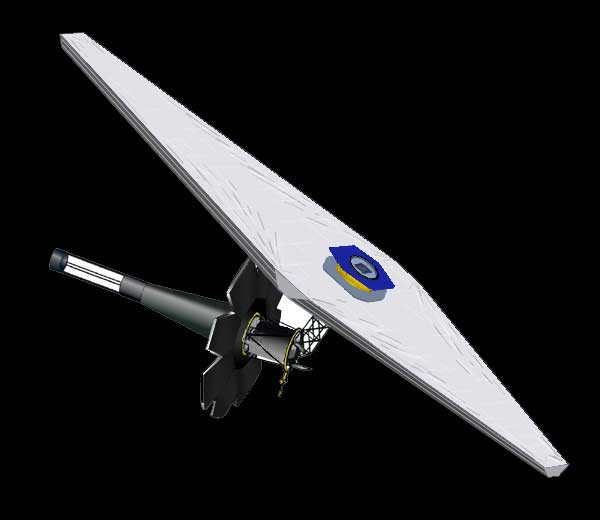 NASA artist conception of the James Webb Space Telescope |
James E. Webb also initiated an energetic space science program with more than 75 launches, including America's first interplanetary explorers.
Launch in 2010. The telescope satellite is scheduled for launch in 2010 aboard a single-use rocket. In space, it will take the satellite about three months to reach an orbit 940,000 miles out in space. At that location, known as the second Lagrange Point or L2, the spacecraft will be balanced between the gravity of the Sun and the gravity of Earth.
At the L2 point, a Sun shield on only one side of the satellite will be sufficient to protect the telescope from the light and heat of both the Sun and Earth.
That means the telescope can be cooled to very low temperatures without complicated refrigeration equipment. Low temperatures are required to prevent its own heat radiation from exceeding the brightness of the distant cool astronomical objects.
Unlike the Hubble Space Telescope, the Webb Telescope will be too far away from earth for service visits by space shuttle astronauts who usually fly only around 250 miles above Earth.
The mirror. The telescope will be able to look deeper into the universe than the Hubble because the Webb's larger mirror will bring increased light-collecting power and its infrared light instruments will be far more sensitive.
The Webb telescope's primary mirror will be at least 20 feet in diameter, providing much more light gathering capability than the Hubble's eight-foot primary mirror.
The Webb Telescope's mirror will be built as petals, which will be folded up before and during launch. When the telescope arrives at L2, ground controllers will radio a command to unfold the mirror petals.
Infrared instruments. The Webb Telescope will carry instruments that are sensitive to the infrared wavelengths of the electromagnetic spectrum. It will carry a near-infrared camera, a multi-object spectrometer, and a mid-infrared spectrometer camera.
The infrared capability will help astronomers understand how galaxies first emerged out of the darkness that followed the rapid expansion and cooling of the Universe just a few hundred million years after the theorized Big Bang. The light from the youngest galaxies is seen on Earth in the infrared range of the electromagnetic spectrum due to the expansion of the Universe.
The Webb Telescope will observe light arriving at Earth from the far visible to the mid-infrared part of the electromagnetic spectrum. The wavelengths covered differ from those of the Hubble, which covers a range from the ultraviolet to the near-infrared.
Closer to home. The Webb Space Telescope will look around our neighborhood of the Milky Way galaxy for signs of the formation of planets in disks around young stars. It also will look beyond our galaxy for supermassive black holes in other galaxies.
Responsibilities. The telescope satellite will be built by Northrop Grumman Space Technology, formerly known as TRW.
The Goddard Space Flight Center, Greenbelt, Maryland, manages the telescope project for NASA's Office of Space Science in Washington, D.C. The European Space Agency and the Canadian Space Agency are involved in the Webb telescope project along with several industry, academic and U.S. government partners.
Learn more...
- James Webb Space Telescope Space Telescope Science Institute (STScI)
- Webb Telescope NASA Goddard
- Webb Telescope FAQ NASA Goddard
- NASA artist conception
- NASA artist conception
- NASA artist conception